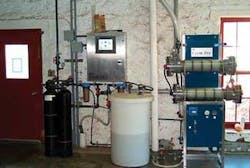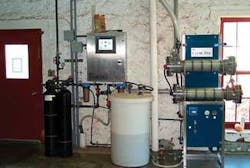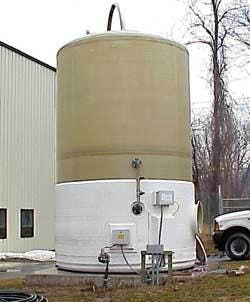United Water Pennsylvania, a water utility serving more than 150,000 people in eight counties in the Keystone state, installed an on-site hypochlorite generating system in 1999 to replace chlorine gas cylinders at its Hummelstown Water Treatment Plant (WTP) just east of Harrisburg. As part of the U.S. Environmental Protection Agency’s (EPA) Environmental Technology Verification program (ETV), the EPA and NSF International verified the performance of the system at installation.
The Hummelstown plant is a conventional WTP consisting of prechlorination, coagulation, clarification, granular media filtration and post chlorination. The water source for the plant is the Swatara Creek, and the turbidity, alkalinity and hardness can vary significantly.
The on-site hypochlorite system installed at the plant was the ClorTecTM Model MC 100. The concentrated hypochlorite generator stream from the treatment system underwent a twice-daily analysis from March 8 to April 6, 2000, using the Standard Methods for the Examination of Water & Wastewater established by the American Public Health Association, the American Water Works Association and the Water Environment Federation.
During the verification procedure, the system operated in the auto batch mode. Generator operation was initiated based on the sodium hypochlorite level in the storage tanks. A 4-20 mA signal from level transmitters on top of each storage tank was sent to the PLC controller, activating the generator if the levels in the hypochlorite storage tanks were below the previously entered set point. Generator operation was terminated based on sodium hypochlorite levels in the storage tanks reaching a previously entered high level set point.
The number of continuous hours of operation was primarily contingent on the WTP production rate, and averaged approximately 13 hours. The hypochlorite metering pumps typically had to be adjusted manually several times daily to account for this operating variable.
No adjustments were made to the dilution water flow, voltage or amperage during the ETV because these parameters and the brine specific gravity were within the ranges specified in the ClorTec MC Operator Interface PLC Manual.
Water Quality Results
The feed water turbidity was low due to coagulation/clarification/filtration of the raw water by the Hummelstown WTP, averaging 0.067 during testing. A free chlorine residual was maintained in the feed water, averaging 0.36 mg/l during the test period. The addition of post sodium hypochlorite provided a free available chlorine residual to achieve compliance with contact time requirements under the EPA Surface Water Treatment Rule (SWTR), and provided a residual disinfectant throughout the distribution system.
Five-day-per-week sampling for Total Coliform, indicator bacteria for potential fecal contamination, showed no positive indications for its presence in either the feed water or treated water. Testing for Heterotrophic Plate Count (HPC), a general indicator for total bacterial levels, revealed its presence in two feed water samples at 15 and 73 colony forming units (cfu)/ml and three treated water samples at 1, 58 and 71 cfu/ml. The dates that exhibited the two higher detections in the treated water corresponded to the sample dates of the two detections in the feed water. There was no indication in the WTP operating records or the ETV logbook of having lost hypochlorite feed during the sampling period when HPC were detected. The most likely reason for the detections was improper sampling procedures.
Six inorganic contaminants commonly found in water supplies were analyzed in the feed water and treated water once during the test period:
- Iron, manganese and bromide were below detection limits in both the feed water and treated water.
- Total dissolved solids (TDS) increased from 139 mg/l in the feed water to 147 mg/l in the treated water; sodium increased from 11.6 mg/l to 13.3 mg/l.
- Chloride increased from 23.8 mg/l to 27 mg/l.
The TDS of the softener wastewater was much higher (7785 mg/l) than the feed water due to the removal and concentration of dissolved minerals in the softener treatment process. These increases in TDS, sodium and chloride were likely due to the addition of sodium hypochlorite to the feed water process.
The presence of ammonia can have a significant impact on disinfection due to the demand it places on chlorine. No ammonia was detected in either the feed water or treated water. The impact of feeding sodium hypochlorite on the alkalinity level was negligible, increasing it from an average of 28 mg/l as CaCO3 to 30 mg/l as CaCO3. With the exception of one set of samples, feed water and treated water alkalinity levels were the same.
Power consumption was recorded daily for voltage and amperage, which was displayed locally on the power supply/rectifier, and remotely on the PLC cabinet LCD screen. The average daily DC current and voltage applied to the electric cells was 183 amps and 46 volts, respectively.
As for maintenance, there were a few items that required maintenance during the ETV, none of which directly involved the ClorTec MC100 system, but rather the softener, pump feed line and pH meter.
The hypochlorite generator electrodes had started to develop a scale formation by the end of the 30-day test, although the scaling had not developed to the point of loss in generator efficiency, requiring acid cleaning. Tim McGarvey, production superintendent for United Water Pennsylvania, found that cleaning the scaling off the electrodes every 900-1,000 hours with an acid bath returned the system to its normal operation.
According to McGarvey, the ClorTec system has met United Water Pennsylvania’s expectations since it was installed at the Hummelstown plant.
“Since 2000, the unit has operated without any unplanned or unscheduled maintenances and has continued to operate, as expected, under any conditions,” McGarvey said.
“We closed the Hummelstown facility in September 2006 and opened a state-of-the art membrane plant on the same site. But we’ve transferred the ClorTec equipment to our Sixth Street Water Treatment Plant as a standby, and we expect that it will continue to operate extremely well,” he added.






